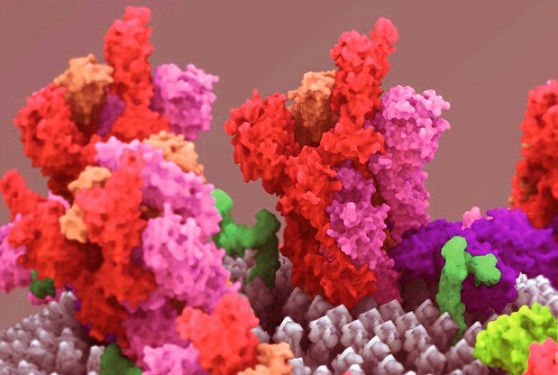Scientists Reveal How the COVID-19 Spike Protein Keeps Wreaking Havoc in the Body Long After Infection!
Nikhil Prasad Fact checked by:Thailand Medical News Team Apr 26, 2025 5 hours, 40 minutes ago
Medical News: A team of Brazilian researchers from the University of Brasília have uncovered critical new insights into how the spike protein of the SARS-CoV-2 virus continues to disrupt bodily systems long after the initial infection phase. In what is now recognized as long COVID, or post-acute sequelae of COVID-19 (PASC), many individuals report persistent symptoms weeks or even months after recovering from the original infection. This
Medical News report dives deep into how interactions between the spike protein and various cellular receptors may be the driving force behind this lingering illness.
 Scientists Reveal How the COVID-19 Spike Protein Keeps Wreaking Havoc in the Body Long After Infection
Scientists Reveal How the COVID-19 Spike Protein Keeps Wreaking Havoc in the Body Long After Infection
The study, conducted by Bruno Pereira de Melo, Jhéssica Adriane Mello da Silva, Mariana Alves Rodrigues, Julys da Fonseca Palmeira, Angélica Amorim Amato, Gustavo Adolfo Argañaraz, and Enrique Roberto Argañaraz, sheds light on how the spike protein’s engagement with both standard and non-traditional receptors triggers widespread inflammation, blood clotting issues, vascular damage, and neurological disruptions.
The Role of Receptor Hijacking
While ACE2 is the most well-known receptor for SARS-CoV-2, researchers point out that the virus exploits many others to gain entry into human cells, especially in tissues where ACE2 is scarcely present. These include TLR2/4, NRP1, DPP4, CD147, and the transferrin receptor (TfR), among others. The spike protein, particularly its S1 subunit, is capable of binding to these receptors, activating a series of dangerous intracellular signals.
One of the key mechanisms involves the ACE2 receptor's downregulation after spike protein binding. This not only disrupts blood pressure regulation but also promotes the release of inflammatory cytokines and vascular leakage. A crucial enzyme called ADAM17 is also activated in this process, contributing to endothelial damage, thrombosis, and organ dysfunction.
Inflammatory Pathways Leading to Long COVID
Beyond ACE2, the spike protein’s interaction with TLR4 and TLR2 receptors triggers strong inflammatory responses, especially in immune cells and brain microglia. These Toll-like receptors are known for detecting harmful pathogens, but their overactivation leads to a cytokine storm and long-term inflammation. In laboratory studies, spike protein exposure led to the production of high levels of inflammatory molecules such as IL-6, TNF-α, and IL-1β.
This inflammatory storm affects multiple organs and systems, especially the brain, where it contributes to symptoms like fatigue, memory loss, headaches, and brain fog—hallmark features of long COVID. Animal studies have even demonstrated cognitive decline following direct exposure to spike protein, without the presence of the entire virus.
Spike Protein Also Impairs Vascular and Neurological Health
The spike protein also inter
acts with Neuropilin-1 (NRP1), a receptor heavily expressed in blood vessels and the brain. This binding contributes to mitochondrial stress, iron accumulation, and cellular aging—a pathway suspected to drive long COVID’s fatigue and brain-related symptoms. Additionally, DPP4, another receptor hijacked by the spike protein, plays a role in diabetes and metabolic issues, which may explain why many long COVID patients experience new-onset diabetes or blood sugar problems after recovery.
CD147, another alternative receptor, indirectly supports viral entry and inflammatory responses. Although its exact role is debated, it may help amplify the effects of other receptors like ACE2, NRP1, and DPP4. The transferrin receptor (TfR), responsible for iron transport, is also implicated in long COVID-related cellular iron overload and oxidative damage.
Affecting the Brain’s Natural Anti-inflammatory System
Perhaps most intriguing is the spike protein’s disruption of nicotinic acetylcholine receptors (nAChRs), which help regulate the brain’s anti-inflammatory response. By impairing these receptors, the spike protein lowers acetylcholine levels, tipping the balance in favor of neuroinflammation. This can result in increased cytokine production in the brain, worsening neurological symptoms.
Hormonal and Estrogen Receptor Disruption
The spike protein even appears to bind estrogen receptor alpha (ERα), which plays roles in immune regulation and blood clotting. This interaction may lead to coagulopathy and inflammation, possibly explaining why certain individuals—particularly women—experience hormonal imbalances and menstrual irregularities following infection.
Conclusions and Implications for Long COVID Treatment
This comprehensive review highlights the spike protein’s ability to hijack various cellular receptors, each contributing to long COVID’s complex symptomology. From vascular inflammation and mitochondrial dysfunction to neurological damage and immune system imbalance, these interactions present a clear picture of how a single viral protein can continue to inflict damage long after the virus is gone.
The findings suggest that therapies targeting the spike protein’s receptor interactions—especially those involving ACE2, TLRs, NRP1, and DPP4—could hold promise in treating or preventing long COVID. Understanding these pathways may also lead to the development of diagnostic biomarkers to identify at-risk patients early.
The study findings were published in the peer reviewed journal: Viruses
https://www.mdpi.com/1999-4915/17/5/619
For the latest on Long COVID, keep on logging to Thailand
Medical News.
Read Also:
https://www.thailandmedical.news/news/covid-19-news-scientists-from-chile-find-that-sars-cov-2-spike-protein-s1-activates-cx43-hemichannels-and-disturbs-intracellular-ca2-dynamics
https://www.thailandmedical.news/news/s1-subunit-of-the-sars-cov-2-spike-protein-can-impact-over-60000-human-proteins-and-2500-biological-processes
https://www.thailandmedical.news/news/phytochemicals-nobiletin-and-eriodictyol-can-help-suppress-neuroinflammation-caused-by-sars-cov-2-spike-protein
https://www.thailandmedical.news/articles/long-covid
https://www.thailandmedical.news/pages/thailand_doctors_listings
